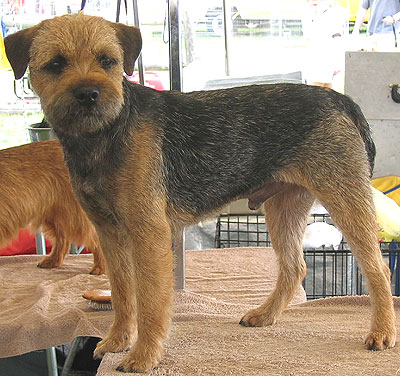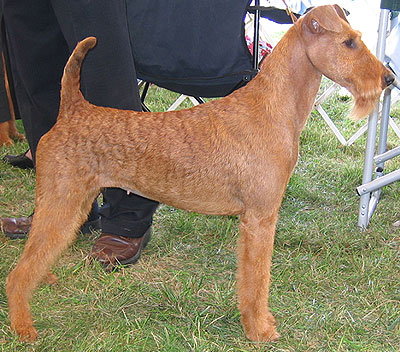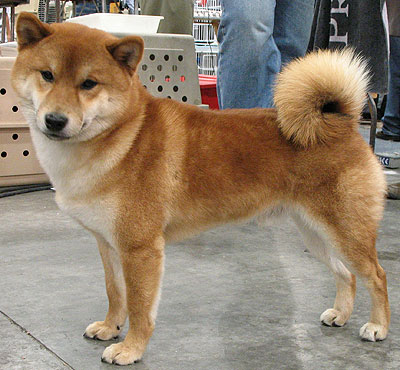I've been working my way back through the dog book (Your Purebred Puppy 1st ed. by Michelle Lowell). It's good enough that I ended up ordering the second edition off Amazon (Your Purebred Puppy, Second Edition: A Buyer's Guide, Completely Revised and Updated) since my copy is nearly due back to the Chicago Public Library.
Ok, on to the Pooch Power Rankings. Even though I desperately want an Irish Terrier, the typical "IT" temperament might be a handful for me, so I'm trying to find a dog that might be better suited for apartment living, and perhaps a little less "plucky, bold, and courageous."
Dog Power rankings as of July 21
#1: Border Terrier

Fine for Novice Owners#2: Irish Terrier
Good with Children
Small in Size
Wiry Coat
Exercise Required: Medium
Trimming/Clipping Required: Medium
Amount of Shedding: Low
Activity indoors: Medium
Ease of Training: High
Sociability with Strangers: High
Size: 12-15 inches tall, weighing 15-18 pounds
Temperament: He is quieter, milder-mannered, and more obedient than most terriers, but still very hardy and plucky. Some Borders are tougher and more work-oriented than others. He's so adaptable that he's fine in any home that gives him daily companionship, long walks, and an occasional run in a safe, enclosed area. He's usually friendly with strangers, but some are timid, so he should be accustomed to people and noises at an early age. Unlike many terriers, he's usually fine with other dogs, but must be watched around small pets like cats and rabbits, for he can be a single-minded chaser. Borders are inquisitive and explorative, and can get themselves into trouble by crawling into tight holes; although their loose skin often enables them to wriggle out by themselves, you should inspect your home for openings that a Border may not be able to resist. Eager to please and sensitive to correction, he's very responsive to obedience training. Never hit a terrier, and don't play aggressive games like wrestling or tug-of-war. He likes to dig; some will bark a bit.
History: This hardy hunter of fox, badger, and barnyard varmints originated in the rugged Cheviot Hills on the border between England and Scotland. Today he is a companion, but he can still dispatch vermin and makes an excellent farm dog. AKC popularity: 88th of 130 breeds.
Appearance: His coat is short and harsh and should be brushed twice a week. Straggly hairs should be scissored and dead hairs stripped twice a year. He is wheaten (tan) or reddish brown, with black tipped hairs and dark ears. Blue-and-tan is less common. A little white on his chest is allowed. His ears hang down. His eyes are dark with a keen expression. His nose is black. His teeth meet in a scissors bite.
Health Problems: He is susceptible to some congenital heart problems. Like many stoic terriers, he is relatively insensitive to pain and shows few signs of illness; it is up to his owner to watch his health carefully.

Fine for Novice Owners#3: Boston Terrier
Good with Children
Medium in Size
Wiry Coat
Exercise Required: Medium
Trimming/Clipping Required: High
Amount of Shedding: Low
Activity indoors: Medium
Ease of Training: Low
Sociability with Strangers: Medium
Size: 18 inches tall, weighing 25-27 pounds
Temperament: This is one of the hardiest, pluckiest, boldest, and most spirited of the terriers. He is also very playful. He is both a gallant gentleman and a fearless daredevil who charges headlong into any situation. He can adapt to any home with daily exercise and companionship. He thrives on games and activities. Don't let him off the leash except in a safe, enclosed area. he is an explorer, an independent chaser, and very fast. He's sensibly friendly with strangers but very protective, so he should be accustomed to people at an early age. He's scrappy with other animals. Although his great stubbornness and energy call for ongoing obedience training (come and stay are especially important commands), he can learn anything. This is one of the most capable and versatile of all breeds. Never hit any terrier, and don't play aggressive games like wrestling or tug-of-war. He can guard his food and toys from family members who have not established leadership over him. He is a digger.
History: Developed in Ireland, he was a true working breed: farm dog, vermin hunter, water retriever, big-game hunter, messenger dog, and patrol dog. Today he is a home guardian and companion, but he can still dispatch vermin. AKC popularity 107th of 130 breeds.
Appearance: His coat is short and wiry, with bushy eyebrows and a beard, and should be brushed and combed twice a week. He needs much scissoring and coat shaping every three months. For pets, coat shaping means electric clipping; for show dogs, it means stripping (plucking) the dead hairs out one by one, because electric clipping softens the coat and fades the color. He is usually red or golden red; wheaten is less common. Some puppies are born with a few black hairs that usually disappear as they grow. A little white on the chest is allowed. His ears fold forward. His eyes are dark with a fiery expression. His nose is black. his teeth meet in a scissors or level bite. His tail is docked.
Health Problems: He is healthy, prone to no real problems.



go for the canaan dog if you can find a breeder in your area.
they really are great!
Hey, thanks for the comment. I ended up just going to the shelter and got a Westie/Schnauzer mix (a wauzer).